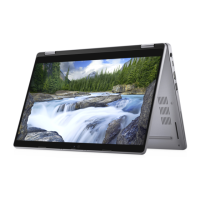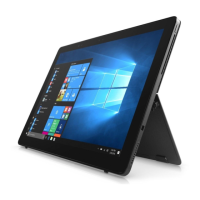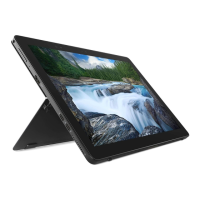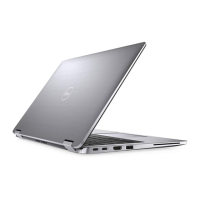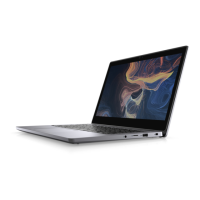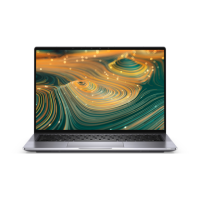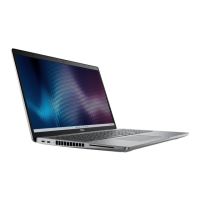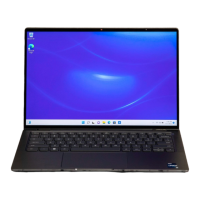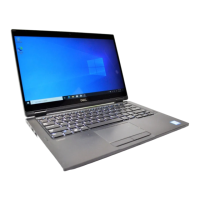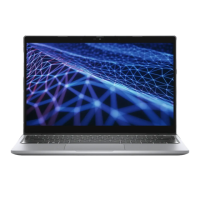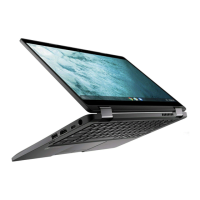
Do you have a question about the Dell Latitude 5300 2-in-1 Chrome and is the answer not in the manual?
| Display | 13.3-inch FHD (1920 x 1080) Touchscreen |
|---|---|
| Operating System | Chrome OS |
| Graphics | Intel UHD Graphics 620 |
| RAM | 8GB |
| Storage | 128GB |
| Ports | MicroSD card reader, 3.5mm headphone/microphone combo jack |
| Wireless | Bluetooth 5.0 |
| Processor | Intel Core i5-8365U |
Provides guidelines for long-term storage of the Chrome device to maintain battery health and system integrity.
Outlines essential safety procedures and precautions to prevent injury and device damage during operation.
Details critical steps to perform before opening the computer to ensure safety and prevent damage.
Lists essential safety measures to follow before and during component handling to prevent hazards.
Explains methods to prevent damage from electrostatic discharge when handling sensitive computer components.
Provides instructions on safely packaging and transporting sensitive computer parts to prevent ESD damage.
Details the necessary steps to reconnect and secure components after internal work.
Lists the necessary tools required for performing component removal and installation procedures.
Provides a detailed list of screws used for different components, including type and quantity.
Step-by-step guide for removing and installing the microSD card from the computer.
Instructions for safely removing and inserting the SIM card tray.
Procedures for removing and reattaching the computer's base cover.
Detailed steps for safely removing and installing the system's battery.
Guide on how to remove and install the system's memory modules.
Instructions for removing and installing the Wireless Wide Area Network (WWAN) card.
Steps for removing and installing the Wireless Local Area Network (WLAN) card.
Procedure for removing and installing the M.2 Solid State Drive (SSD).
Guide on how to remove and install the computer's speakers.
Steps for removing and installing the internal system cooling fan.
Instructions for removing and installing the system's heatsink.
Guide on how to remove and install the power adapter port.
Steps for removing and installing the LED indicator board.
Procedure for removing and installing the touchpad button board.
Detailed steps for removing and installing the main system board.
Guide on how to remove and install the coin-cell battery.
Instructions for removing and installing the entire display assembly.
Steps for removing and installing the system's keyboard.
Procedure for removing and installing the palmrest assembly.
General guidance and initial steps for resolving common computer issues.
Troubleshooting steps for problems related to the computer not powering on or charging.
Solutions for common problems related to the display, audio output, screen visuals, and camera functionality.
Steps to resolve problems encountered when pairing or using Bluetooth devices.
Troubleshooting tips for unresponsive touchpads or non-functional keyboard hotkeys.
Guidance for resolving various problems encountered with the Chrome operating system.
Information on using the Chrome Shell (CROSH) and its commands for system diagnostics and troubleshooting.
Lists common CROSH commands for hardware diagnostics like battery and memory checks.
Procedure to check the battery's charge status and health using CROSH commands.
Steps to perform memory diagnostics using CROSH commands to identify potential issues.
Guide on using CROSH commands to diagnose network connectivity and status.
Guidance on system recovery, OS reinstallation, and factory reset procedures.
Process for reinstalling the Chrome OS to resolve software issues or restore the device.
Detailed steps to reinstall the Chrome OS from recovery media.
How to perform a factory reset (Powerwash) to clear data and restore original settings.
Information and procedures for various built-in diagnostic tools.
Introduction to the LCD self-test for diagnosing screen-related hardware problems.
Instructions on how to initiate the LCD built-in self-test for screen diagnostics.
Explains the meaning of diagnostic LED blink patterns for error indication.
Information on using the M-BIST tool for advanced motherboard failure diagnostics.
Introduction to the ePSA system diagnostics for comprehensive hardware checks.
Overview of the ePSA diagnostic software's basic and advanced screen layouts.
How to interpret and respond to error messages generated during ePSA diagnostics.
Tools and methods for validating diagnostic error codes.
Guide for using the online tool to validate ePSA error codes.
Instructions for using a mobile app to scan QR codes for ePSA error validation.
Links and information for accessing Dell's online support resources, manuals, and drivers.
Details on how to contact Dell support for sales, technical assistance, or customer service.

